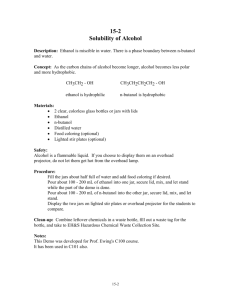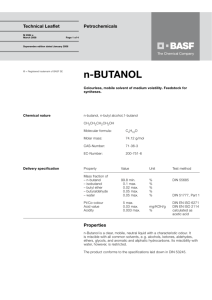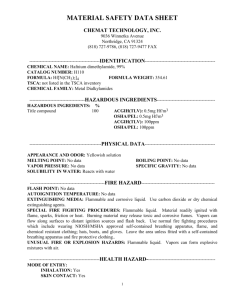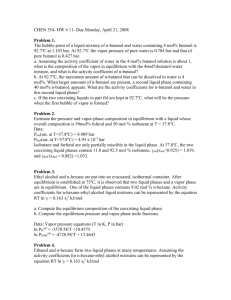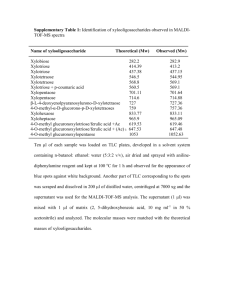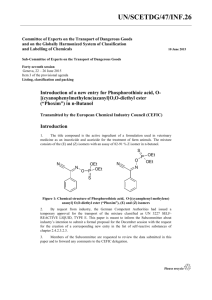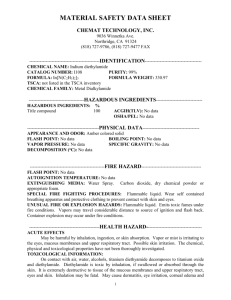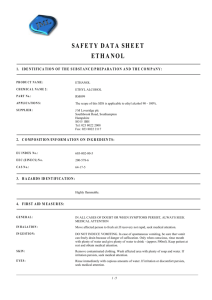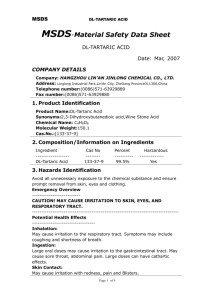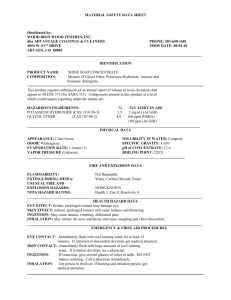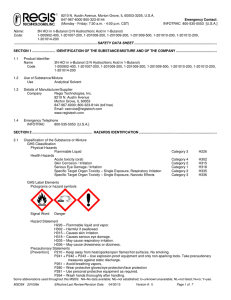Document
advertisement
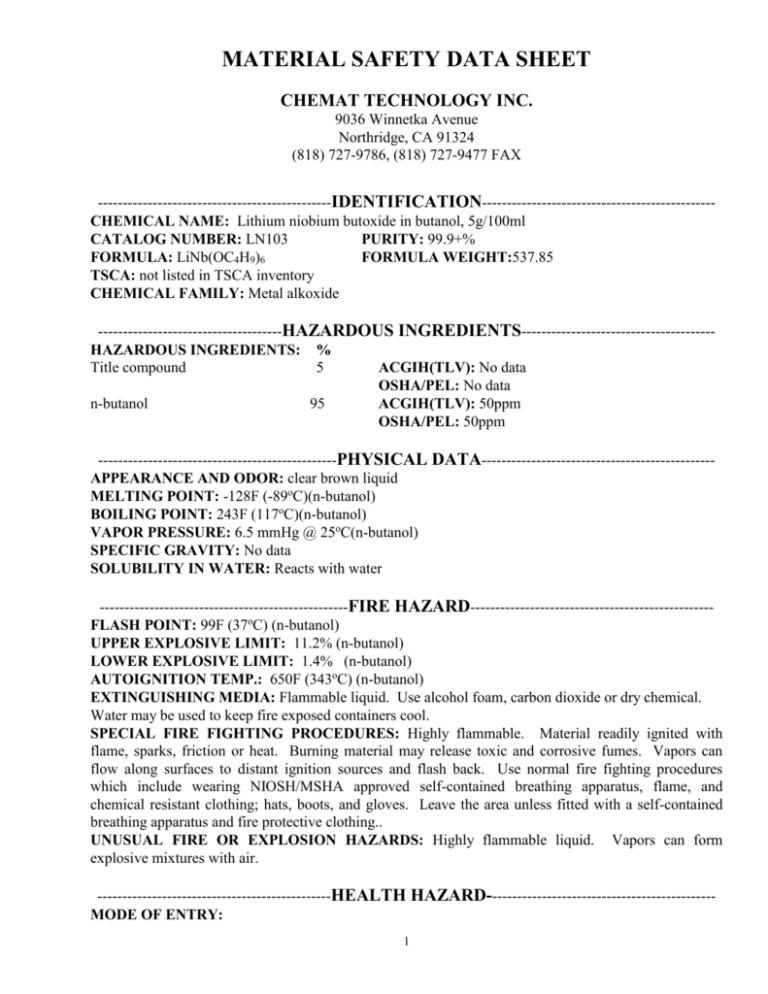
MATERIAL SAFETY DATA SHEET CHEMAT TECHNOLOGY INC. 9036 Winnetka Avenue Northridge, CA 91324 (818) 727-9786, (818) 727-9477 FAX -----------------------------------------------IDENTIFICATION----------------------------------------------CHEMICAL NAME: Lithium niobium butoxide in butanol, 5g/100ml CATALOG NUMBER: LN103 PURITY: 99.9+% FORMULA: LiNb(OC4H9)6 FORMULA WEIGHT:537.85 TSCA: not listed in TSCA inventory CHEMICAL FAMILY: Metal alkoxide -------------------------------------HAZARDOUS INGREDIENTS--------------------------------------HAZARDOUS INGREDIENTS: % Title compound 5 ACGIH(TLV): No data OSHA/PEL: No data n-butanol 95 ACGIH(TLV): 50ppm OSHA/PEL: 50ppm ------------------------------------------------PHYSICAL DATA----------------------------------------------APPEARANCE AND ODOR: clear brown liquid MELTING POINT: -128F (-89oC)(n-butanol) BOILING POINT: 243F (117oC)(n-butanol) VAPOR PRESSURE: 6.5 mmHg @ 25oC(n-butanol) SPECIFIC GRAVITY: No data SOLUBILITY IN WATER: Reacts with water --------------------------------------------------FIRE HAZARD------------------------------------------------FLASH POINT: 99F (37oC) (n-butanol) UPPER EXPLOSIVE LIMIT: 11.2% (n-butanol) LOWER EXPLOSIVE LIMIT: 1.4% (n-butanol) AUTOIGNITION TEMP.: 650F (343oC) (n-butanol) EXTINGUISHING MEDIA: Flammable liquid. Use alcohol foam, carbon dioxide or dry chemical. Water may be used to keep fire exposed containers cool. SPECIAL FIRE FIGHTING PROCEDURES: Highly flammable. Material readily ignited with flame, sparks, friction or heat. Burning material may release toxic and corrosive fumes. Vapors can flow along surfaces to distant ignition sources and flash back. Use normal fire fighting procedures which include wearing NIOSH/MSHA approved self-contained breathing apparatus, flame, and chemical resistant clothing; hats, boots, and gloves. Leave the area unless fitted with a self-contained breathing apparatus and fire protective clothing.. UNUSUAL FIRE OR EXPLOSION HAZARDS: Highly flammable liquid. Vapors can form explosive mixtures with air. -----------------------------------------------HEALTH HAZARD---------------------------------------------MODE OF ENTRY: 1 INHALATION: Yes SKIN CONTACT: Yes EYE CONTACT: Yes INGESTION: Yes CARCINOGENCITY: NTP: Not known IARC: Not known OSHA: Not known EFFECTS OF OVEREXPOSURE: INHALATION: Lithium compounds have been implicated in development of aplastic anemia. Lithium ion has central nervous system toxicity. Limited animal experimentation show high toxicity for some salts of niobium. Animal experiments have also shown toxicity effects related to disturbed enzyme action. Material may cause irritation of the nose and throat. Exposure to high concentrations has a narcotic effect, producing symptoms of drowsiness, headache, staggering, unconciousness, and possibly death. SKIN CONTACT: Lithium oxide or hydroxide, carbonate, etc., are strong bases and these solutions in water are very caustic. n-butanol may cause mild skin irritation. Prolonged and/or repeated contact may cause defatting of the skin and dermatitis. EYE CONTACT:Causes severe eye irritation. INGESTION: Large of doses of lithium compounds have caused dizziness and prostation. Can cause kidney damage, anorexia, nausea, apathy, coma and death. 2-butanol may cause irritation of the digestive tract. May cause central nervous system depression, characterized by excitement, ollowed by headache, dizziness, drowsiness, and nausea. Advanced stages may cause collapse, unconsiousness, coma and possible death due to respiratory failure. EMERGENCY AND FIRST AID PROCEDURES: INHALATION: Get medical aid immediately. Remove from exposure to fresh air immediately. If not breathing , give artificial respiration. If breathing is difficult, give oxygen. SKIN CONTACT: Wash the affected area with soap and water for at least 15 minutes. Get medical aid if irritation persists. EYE CONTACT: Immediately flush eyes, including under eyelids, with large amounts of water for at least 15 minutes. Call a physician. INGESTION: Give the victim plenty of water. Never give anything by mouth to an unconscious person. Get medical aid immediately. -----------------------------------------------REACTIVITY DATA-------------------------------------------STABILITY: Moisture-sensitive material. CONDITIONS TO AVOID: Contact with ignition source or heat. INCOMPATIBILITY: Moisture, heat, strong oxidizers, acetaldehyde, chlorine, ethylene oxide, hydrogen-palladium combination, nitroform, phosgene, hydrogen peroxide-sulfuric acid combination, potssium tert-butoxide, hypochlorous acid, isocyanates, oleum, perchloric acid, aluminum isopropoxide, crotonaldehyde. HAZARDOUS DECOMPOSITION PRODUCTS: CO, CO2, lithium hydroxide, niobium oxide, acrid smoke and fumes HAZARDOUS POLYMERIZATION: has not been reported. ---------------------------------ENVIRONMENTAL INFORMATION-------------------------------SPILL OR LEAKAGE PROCEDURES: Wearing full protective equipment, eliminate all sources of ignition. Cover spill with dry sand or vermiculite. Sweep up the mixture and dispose of properly. WASTE DISPOSAL: Consult state, local, or federal EPA regulations for proper disposal. 2 ----------------------------------PROTECTION AND PRECAUTIONS-------------------------------VENTILATION REQUIREMENTS: Glove bag or inert atmosphere. RESPIRATORY PROTECTION: NIOSH/MSHA approved respirator with an organic vapor cartridge. PROTECTIVE GLOVES: Rubber EYE/FACE PROTECTION: ANSI approved safety goggles HANDLING AND STORAGE: Handle and store the material underan inert atmosphere of nitrogen or argon. Keep away from heat. OTHER PRECAUTIONS: The material will react with air and moisture. Lab coat and apron, flame and chemical resistant coveralls, eyewash capable of sustained flushing, safety drench shower and hygienic facilities for washing. --------------------------------------------------------------------------------------------------------------------------The information herein is believed to be accurate and reliable as of the date compiled. However, Chemat Technology Inc. makes no representation, warranty or guarantee of any kind with respect to the information on this data sheet or any use of the product based upon this information. DATE PREPARED: September 19, 2002 3
